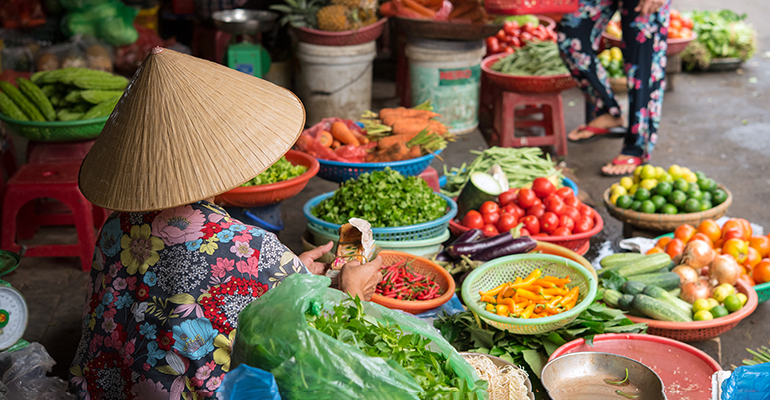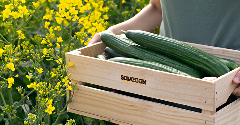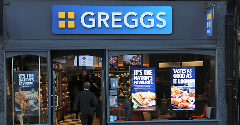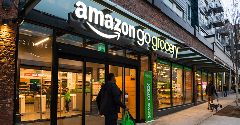News
Catering to the ‘new’ Vietnamese consumer
20 Jun 2023
Vietnam’s food industry is evolving to meet the needs of “the new face of the Vietnamese consumer” after shifts in consumer class, demographics, and digitalisation, says McKinsey.
Vietnam has remained a dominant force in manufacturing, largely due to its ongoing investment activity and recognised potential in food and drink new product developments (NPD).
In 2023, revenue in Vietnam’s food scene is expected to grow to $93.06 billion (€87.4 bn), with a compound annual growth rate (CAGR) of 8.20% between 2023-2028. Confectionery and snacks comprise the largest segment within the Vietnamese food sector, amounting to a market volume in 2023 of $14.31 billion (€13.4 bn). In the food sector, 1.2% of total revenue is projected to come from online sales in 2023.

The Southeast Asian country’s manufacturing market has been revered for its long history of positive growth, a McKinsey report indicates. Through the first 20 years of the century, it saw a CAGR increase of 5%, 1.7% faster than the global average’s increase. Despite Covid-19's impact on the food industry, Vietnam still achieved 2.9% in gross domestic product (GDP) growth in 2020.
The next phase of Vietnam’s food future shows no signs of slowing down, with research indicating the Southeast Asian country is in the midst of a ten-year $10 trillion (€9.3 trillion) consumption growth opportunity. However, while Vietnam’s success story is set to stay the same, its consumer is set to change.
Welcoming the growing consumer classes
A new consumer has emerged in Vietnam. And so, as we move into the country’s latest food and beverage evolution phase, producers will need to examine how the country’s demographic landscape is shifting and subsequently shaping how they consume and what they demand from food manufacturers.
One of the most significant changes in Vietnam is to its consuming class, which refers to the number of people who spend a minimum of $11 a day according to the country’s purchasing power parity (PPP) terms, a specific measurement of the price of food and beverages. By 2030, a potential 36 million more consumers may become part of the country’s PPP, representing almost 75% of Vietnam’s population. Today, this figure is close to 40%, having increased from less than 10% in 2000.
New consumers entering the class and income rises account for the growing consumption power. Urbanisation and subsequent income hikes play a more significant role in Vietnamese consumers’ spending. The two highest consuming class tiers, those that spend $30 or more a day, may make up a fifth of the population within the next decade.
Demographic and digital details
Urbanisation is leading to smaller households in Vietnam, changing how consumers shop and which goods they purchase. Other Asian markets have seen reduced household numbers resulting in new demands, which may impact consumption and purchasing patterns in Vietnam in a similar way.
The senior demographic class is also set to increase, with over 17% of the population expected to be over 60 by 2030. Spending is projected to triple among seniors in this same period, too. Women’s economic empowerment is also changing the face of consumption. In 2019, Vietnam held one of the world’s highest female-to-male ratios in the workforce, at 88%. By 2030, female consumers may contribute an extra $80 billion to Vietnam’s GDP.
 © AdobeStock/wooooooojpn
© AdobeStock/wooooooojpn
The environment the consumer shops in is changing, too. Amid Covid-19, an increasing number of consumers have embraced digital tools, spurring new developments. A study found that 41% of all digital consumers in the country are new, and 91% planned to continue using their digital tools beyond the pandemic, the McKinsey report indicates. Online and mobile use to conduct research and commerce is expected to grow, with Generation Z and millennials accounting for approximately 40% of Vietnam’s consumption, McKinsey says.
Calls for consciousness and transparency
Consumer lifestyles and behaviour choices signal the importance of how brands treat wider society and the environment. In a consumer survey, 91% of Vietnamese participants said they are aware of and actively engaging in a conscious lifestyle, McKinsey research reveals. The figure is higher than Indonesia (86%), Malaysia (75%) and Thailand (73%).
The potential for premiumisation exists too, with more consumers aware of sustainability and social responsibility. In the survey, 84% of Vietnamese participants said they are willing to pay a premium for conscious-lifestyle products.
In Vietnam, 64% of consumers say they check product labels, which contain information including ingredients and nutrition, when shopping for food and drink, a survey by market intelligence company Mintel revealed. Results revealed that 61% of consumers in the Philippines would check food and beverage labels, while 56% of those in Thailand would.
“Today, consumers want more control over their wellbeing,” said Heng Hong Tan, Food and Drink Analyst at Mintel APAC. “Food and drink brands have the complex task of conveying clear and reliable guidance so that a product will meet consumers’ health priorities,” Tan added. Clear on-pack labelling information relating to dietary requirements can provide this assurance.
Keeping up with the new consumer
Vietnamese food and beverage manufacturers’ focus is on diversifying, modernising and digitising their product offerings. Producers will need to understand market developments and variations, communication demands and commit to localisation and agility to reflect Vietnam’s new consumers.
Related news

UK Government overhauls childhood obesity strategy
21 Nov 2025
The UK Government has announced a new package of measures designed to reverse the nation’s childhood obesity epidemic following the release of statistics revealing the scale of the crisis.
Read more
Nitrites: Pressure grows on UK to follow EU’s lead
20 Nov 2025
Pressure is growing on the UK to follow the EU’s lead after the bloc revised its regulations on the permitted levels of nitrites and nitrates in cured meats.
Read more
How younger consumers are redefining ingredient choices and rejecting brand loyalty
18 Nov 2025
Gen Z and millennial consumers’ preferences for transparency, functionality, and purpose are “redefining the very nature of consumption itself”, says SPINS.
Read more
Soy story: WWF scores UK supermarkets on sustainability efforts
12 Nov 2025
WWF has published its latest “Soy Scorecard”, ranking UK supermarkets’ efforts to combat deforestation and land conversion in their soy supply chains.
Read more
New UPF standard hoped to offer consumers ‘coherence and clarity’
10 Nov 2025
Ingredients companies are being urged to enter “a new era of partnership and innovation” following the launch of the industry’s first non-UPF verification scheme.
Read more
Could plant-based protection replace plastic packaging?
29 Oct 2025
Swedish foodtech company Saveggy has launched an additive-free plant-based protection for cucumbers, offering a waste-free packaging solution for fruit and vegetables.
Read more
Does promoting protein content push up plant-based sales?
27 Oct 2025
Promoting the protein content of meat-free products is a more effective sales strategy than adding carbon labels, a study of UK bakery chain Greggs suggests.
Read more
NMN: An on-trend ‘fountain of youth’ ingredient for anti-ageing products
24 Oct 2025
Dubbed an “on-trend fountain of youth ingredient” by Mintel, NMN is booming in anti-ageing ingestible products in Asia – but regulatory roadblocks are thwarting NPD efforts elsewhere, say experts.
Read more
Will Wicks’ Killer Bar harm the protein bar category?
23 Oct 2025
Joe Wicks’ deliberately dangerous protein bar is fuelling anti-UPF sentiment – but there are concerns that his messaging is misguided and could have unintended consequences.
Read more
Amazon Grocery launch aims to balance quality with affordability
22 Oct 2025
Global e-commerce giant Amazon has introduced a new private-label food brand, combining existing Amazon Fresh and Happy Belly products with new everyday items.
Read more